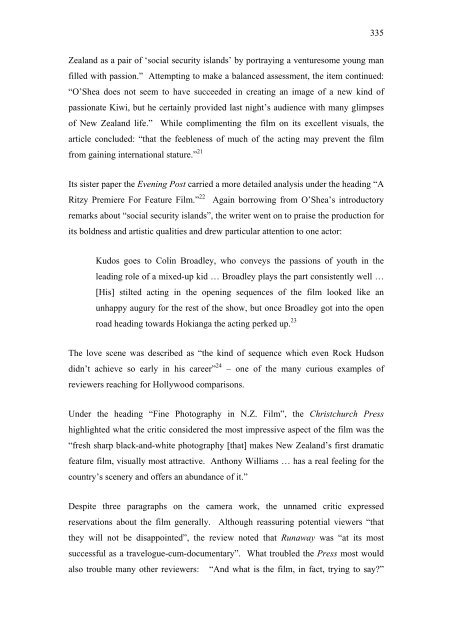Copyright Statement - ResearchSpace@Auckland
Copyright Statement - ResearchSpace@Auckland
Copyright Statement - ResearchSpace@Auckland
You also want an ePaper? Increase the reach of your titles
YUMPU automatically turns print PDFs into web optimized ePapers that Google loves.
335<br />
Zealand as a pair of ‘social security islands’ by portraying a venturesome young man<br />
filled with passion.” Attempting to make a balanced assessment, the item continued:<br />
“O’Shea does not seem to have succeeded in creating an image of a new kind of<br />
passionate Kiwi, but he certainly provided last night’s audience with many glimpses<br />
of New Zealand life.” While complimenting the film on its excellent visuals, the<br />
article concluded: “that the feebleness of much of the acting may prevent the film<br />
from gaining international stature.” 21<br />
Its sister paper the Evening Post carried a more detailed analysis under the heading “A<br />
Ritzy Premiere For Feature Film.” 22 Again borrowing from O’Shea’s introductory<br />
remarks about “social security islands”, the writer went on to praise the production for<br />
its boldness and artistic qualities and drew particular attention to one actor:<br />
Kudos goes to Colin Broadley, who conveys the passions of youth in the<br />
leading role of a mixed-up kid … Broadley plays the part consistently well …<br />
[His] stilted acting in the opening sequences of the film looked like an<br />
unhappy augury for the rest of the show, but once Broadley got into the open<br />
road heading towards Hokianga the acting perked up. 23<br />
The love scene was described as “the kind of sequence which even Rock Hudson<br />
didn’t achieve so early in his career” 24 – one of the many curious examples of<br />
reviewers reaching for Hollywood comparisons.<br />
Under the heading “Fine Photography in N.Z. Film”, the Christchurch Press<br />
highlighted what the critic considered the most impressive aspect of the film was the<br />
“fresh sharp black-and-white photography [that] makes New Zealand’s first dramatic<br />
feature film, visually most attractive. Anthony Williams … has a real feeling for the<br />
country’s scenery and offers an abundance of it.”<br />
Despite three paragraphs on the camera work, the unnamed critic expressed<br />
reservations about the film generally. Although reassuring potential viewers “that<br />
they will not be disappointed”, the review noted that Runaway was “at its most<br />
successful as a travelogue-cum-documentary”. What troubled the Press most would<br />
also trouble many other reviewers: “And what is the film, in fact, trying to say?”















